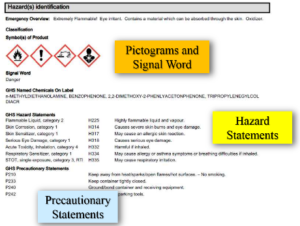GHS provides a consistent way to determine the hazards of substances and mixtures (preparations) and a standardized presentation of these hazards. The outcome of a GHS hazard determination may include:
 GHS Hazard Statements and hazard Classes and Categories
GHS Hazard Statements and hazard Classes and Categories- GHS Precautionary Statements
- GHS Hazard Pictograms (symbols)
- GHS Signal Words
This approach to classification is very similar to the earlier EU Risk and Safety Phrase approach used in their DPD regulation, where the new GHS Hazard Statements are somewhat equivalent to the now obsolete EU Risk Phrases and GHS Precautionary Statements perform the same duty as EU Safety Phrases.
For many hazards, GHS Hazard Statements are assigned directly to pure substances to identify a specific hazard. For example, for a substance which has Acute Toxicity may be assigned an Acute Toxicity statement if the toxicity is high enough. For example, a substance with a toxicological lethal dose value (LD50 oral) between 50 and 300 mg/kg would be assigned:
- H301 Toxic if swallowed, Acute Toxicity, oral, category 3
For mixtures, it is a bit more complicated as the many hazards of the mixture are determined (in most cases) from a combination of the substance hazards.
 In GHS, there are three major methods used to calculate the hazards of a mixture. First, for a mixture which contains acute toxins, the contributing substance toxicological values are “averaged” using a calculation called the Acute Toxicity Estimate (ATE). If the resulting “average” falls within a hazardous range, then the mixture is classified with the appropriate GHS Acute Toxicity hazard statement. Next, for many other health hazards (carcinogenicity, reproductive toxicity, eye irritation, aquatic hazards, etc.), the mixture is classified based upon corresponding hazard statements entered on the substances contained within the mixture. So, for example, if the mixture contains a substance marked for “Carcinogenicity, category 2” at above 0.1 weight % (the “threshold value” for this hazard), then the mixture is also classified for this hazard. Third, for many, mostly physical hazards, like flammability, explosivity, corrosivity, etc. the physical characteristics of the mixture are used to determine the hazard independent of the mixture’s composition. For example, the mixtures flash point and boiling point are used to determine the mixtures flammability, and the pH of the mixture can determine whether the mixture is corrosive.
In GHS, there are three major methods used to calculate the hazards of a mixture. First, for a mixture which contains acute toxins, the contributing substance toxicological values are “averaged” using a calculation called the Acute Toxicity Estimate (ATE). If the resulting “average” falls within a hazardous range, then the mixture is classified with the appropriate GHS Acute Toxicity hazard statement. Next, for many other health hazards (carcinogenicity, reproductive toxicity, eye irritation, aquatic hazards, etc.), the mixture is classified based upon corresponding hazard statements entered on the substances contained within the mixture. So, for example, if the mixture contains a substance marked for “Carcinogenicity, category 2” at above 0.1 weight % (the “threshold value” for this hazard), then the mixture is also classified for this hazard. Third, for many, mostly physical hazards, like flammability, explosivity, corrosivity, etc. the physical characteristics of the mixture are used to determine the hazard independent of the mixture’s composition. For example, the mixtures flash point and boiling point are used to determine the mixtures flammability, and the pH of the mixture can determine whether the mixture is corrosive.
